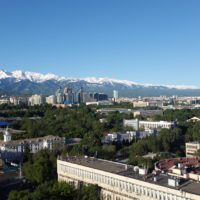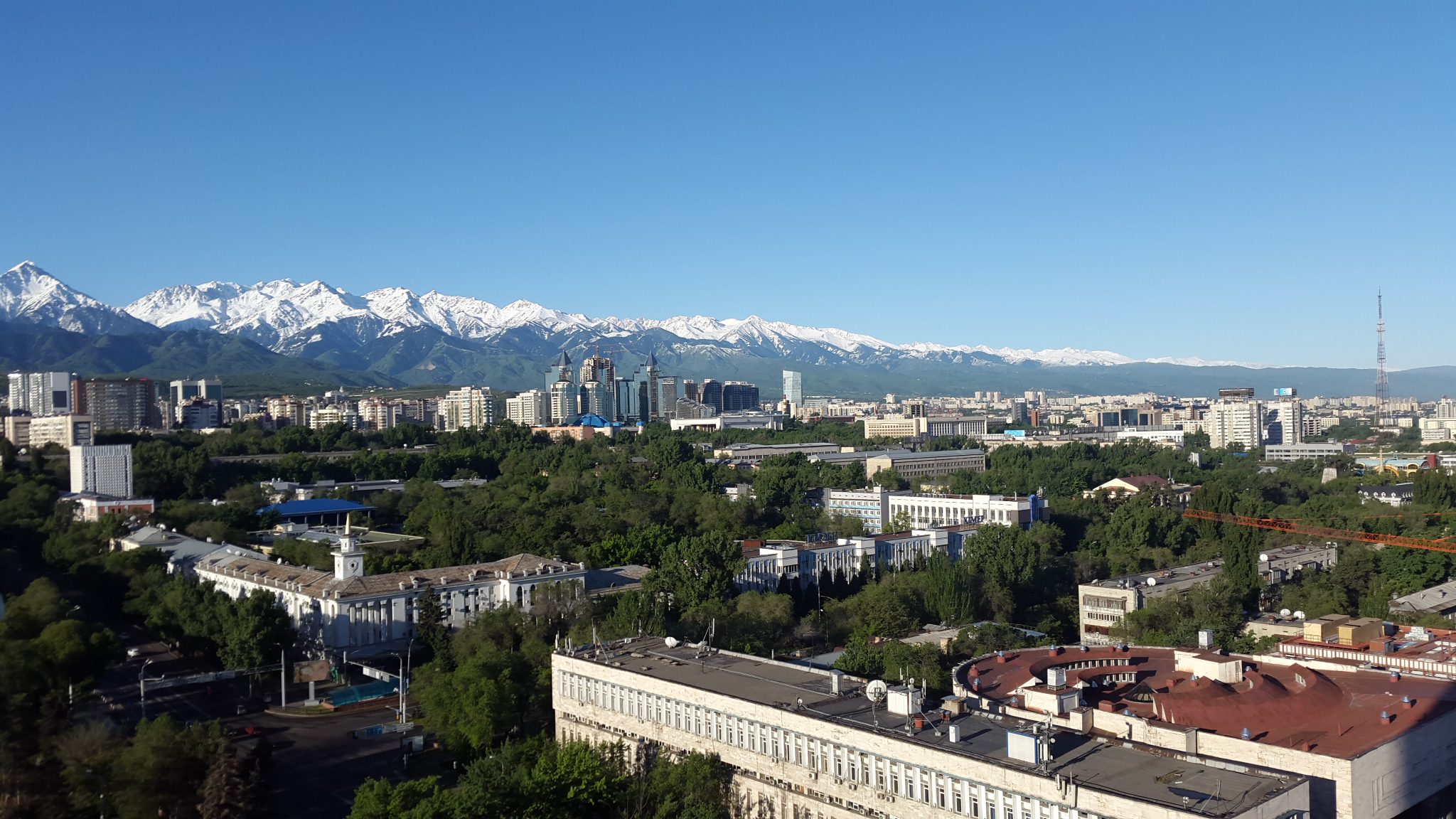In one of the walls of the Kasteyev State Arts Museum in Almaty hangs the painting of a tall Kazakh man driven to transform the world by acts of civil disobedience, a poet consumed by nightmares of environmental disaster. The Poem About Immortality portrait by Amandos Akanaev shows Olzhas Suleimenov in a white, almost celestial suit standing behind a microphone, hands extended like fans, his mouth half-open as if in the middle of a long vowel sound, a cry of contained urgency. His brow is furrowed, the expression of someone determined to become the voice of change.
The Kasteyev Museum stands on the corner of Satpaev Street and Musrepov Boulevard, about a thirty-minute walk from my hotel. Standing by the window of my room on the eighteenth floor, I can see the Tian Shan mountains, giants resting in silence, their jagged profiles buried in snow. The long mountain chain extends from left to right, as far as the eye can see, geological guardians that seem to be breathing the blue of the Almaty sky. It was in this city, formerly called Alma-Ata, that Olzhas Suleimenov was born in 1936.
Before my trip to Kazakhstan I knew little about the literary history of the country but I saw the journey as a gift to my curiosity. In my backpack I carried a thin poetry book recommended by Vanessa Londoño, a Colombian novelist and poet I met at the OMI Writers literary residency in the Hudson Valley this spring. “You have to read it,” she said, after I confessed I hadn’t read any of José Emilio Pacheco’s poems. “Pacheco is one of my favorite poets in the world.” With her sleeves rolled up and a strand of hair over her face, she beat the eggs and mixed butter with flour, made churros and caramel spread one afternoon for all the residents. She wanted us to taste her churros, she explained. She carries an aura of kindness wherever she goes. For many years my grandmother lived in a neighborhood not far from where Pacheco used to wander with a notebook in his breast pocket, eating soursop ice cream and jotting down ideas, overhearing conversations for his stories. Stories that are dense with carbon dioxide and red cells, the veins of Mexico City, because Pacheco captured the pulse of a metropolis and its people in each paragraph. His poems, however, remain unchartered territory to me, like Suleimenov’s at the time I boarded the plane bound for Almaty.
It’s 5:45 a.m. on my second day in Almaty and the early sunlight pours into the room like a troupe of noisy children; it’s impossible to sleep any more. On the nightstand lie scattered some of the newspapers I picked up at Istanbul’s airport, the front pages announcing the grim outlook for Italy, warnings of global trade wars, the capricious diplomatic dance between the US and North Korea, the fragile state of the nuclear agreement with Iran.
I look out the window and gaze at the horizon, the thin line of pink and purple gas floating over the mountains, and I wonder how the sky must have looked the morning of February 27, 1989, when Suleimenov appeared on live TV and instead of reciting a poem he read the manifesto that would end all nuclear testing at the Semipalatinsk Nuclear Polygon. Between 1949 and 1989, the Soviet Union conducted more than four hundred nuclear explosions at the Polygon with the cumulative power of 2,500 times the Hiroshima bomb. Inspired by the Nevada Test Site activists, Suleimenov was able to garner the support from the Kazakh people and the following day, on February 28, thousands gathered at the writers’ union to march together and demand the shutdown of the Polygon. For years, unofficial reports had shown abnormal high levels of cancer among the general population, as well as birth defects, but Soviet authorities remained impassive. After Suleimenov’s call to peaceful civil disobedience, there was no turning back.
As in the case of many artists, Suleimenov’s life has been a collection of canvases, torn and re-sewn, blotched with sweat and glory, at times lauded and revered, others ostracized. At eighty two, the sunset of his public career warms up his quiet days of contemplation; the steep hills of political activism are behind him. In 1975 he published the acclaimed and controversial book AZiYA―its title a combination of the Kazakh and Russian words for “I,” together making the sound “Asia”―where he explored the importance of the role of Turkic-speaking people in the cultural and political context of Eurasia. Veering away from the conventional Eurocentric view sponsored by the Soviet regime, the book was pulled from the shelves and overnight Suleimenov found himself labeled as a dissident, a pariah in the literary world. He escaped imprisonment thanks only to the protection of Dinmukhamed Kunaev, First Secretary of the Communist Party of Kazakhstan, who was able to take the long view and to perceive the transcendence of the poet’s work.
Throughout his life he traveled extensively, eager to explore his country and other parts of the Soviet Union, his native city of Alma-Ata a constant source of inspiration, the streets and the landscape, the convergence of Russian and Kazakh cultures. From a young age, I discovered, Suleimenov was able to render with sheer clarity the Kazakh nomadic spirit in the Central Asian steppes. This ability remained a part of his creative sensibility throughout his career. In “We Are Nomads,” dedicated to the Russian poet Andrei Voznesensky―who also fell out of favor with the Soviet authorities, specifically Nikita Khrushchev―Suleimenov writes with unrestrained emotion:
Andrei! We are nomads, the two of us―the spaces of cultures and eras
divide us,
we wander different routes,
like god and religion
Suleimenov the nomad, the climber of high walls of adventure. In the early spring of 1961, he became privy to the Soviet Union’s plans to send a human into space, and in a frenzy-like state he wrote “Zemlia poklonis’ cheloveku,” a poem that extolled the power of the human intellect, the myriad of possibilities that awaited humankind in outer space. On April 12, 1961, the Vostok spacecraft would be launched from the Baikonur Cosmodrome in southern Kazakhstan, Yuri Gagarin becoming the first human to ever orbit the earth. Suleimenov was invited to give readings in Paris and New York in the summer of 1961, an honorary privilege given to a Soviet artist only months after the Bay of Pigs invasion, a year before the Cuban Missile Crisis.
In Almaty I go for a morning walk. It’s quarter past seven and the urban noise appears to bounce off the surface of office buildings, cars and trucks at a near standstill becoming a stark contrast with the dense lines of trees and vegetation all around. On Dostyk Avenue I stop before the statue of a reflective man wearing a cape and carrying a book. A young passerby, perhaps a university student, tells me it’s the statue of Abay Kunanbayev, one of the most important Kazakh poets of the XIX century. “He found beauty in Kazakh culture and folklore,” she explains to me. On the pedestal he seems to be gazing at the mountains in the horizon, a pensive gait captured for eternity, his mind perhaps stringing sentences together, syllables that could become musical images of this landscape.
I trace back my steps, not knowing where I’m going. I’m not intent on following a straight road to anywhere in particular. After a few meters I find another monument, this time the image of Ukrainian poet Taras Shevchenko, who is considered one of the pillars of modern Ukrainian literature. I take out my notebook and try to sketch his face, the thick mustache, the high brow and deep set eyes. As I finish the contours of his face, the proximity of these two monuments strikes me as unusual. Perhaps Kazakh people hold a high respect for poetry. The second realization is the similarity among these four poets: Pacheco, Suleimenov, Shevchenko, Abay—all of them tapped into the creative well of their own folkloric and cultural traditions.
At OMI Writers I met Bettina Münch, a nonfiction writer and translator who has translated some of Rebecca Solnit’s works into German. During the days we spent together, she shared some of the complexities, as well as the pleasures, inherent to translation. “You have to do a lot of research,” she explained to me. “It means reading lots and lots before you can translate even one sentence. You have to understand how the author thinks.”
I had read some of Solnit’s essays, and after speaking with Bettina I decided to go deeper into Solnit’s oeuvre. “Thought becomes action becomes the order of things, but no straight road takes you there,” she wrote in her essay, “On the Indirectness of Direct Action.” In the 1980s, Solnit was a member of the Nevada Desert Experience, an activist movement that aimed to stop nuclear testing in the US. In the same essay, Solnit writes:
The Soviet Polygon test site was shut down. The catalyst was Suleimenov, and though we were his inspiration, what gave him his platform was his poetry in a country that loves poets.
When I come back to have breakfast at the hotel, I read more news online about the situation in North Korea. What will happen if the dialogue is broken?, I wonder. Could the situation escalate, and if so, what would the consequences be? The same day, at midmorning, I hear the Minister of Foreign Affairs of the Republic of Kazakhstan, Kairat Abdrakhmanov, say:
We believe North Korea can see Kazakhstan as an example. It is possible to give up nuclear aspirations, have a safer world, and at the same time become a prosperous nation.
That evening, before going to dinner, I open the window and feel the cool air in my face. The shape of the Tian Shan mountains can be seen in the distance, an intimation of something bigger than I could ever grasp. I close my eyes and breathe in, hear a siren go off in the distance.
Some words linger in my mind, words that Olzhas Suleimenov wrote while peering at the world without fear:
What do you know, clouds
are massed above the towns,
there’s no way through just now.
I ride above the clouds.
***
Photographs provided courtesy of author.







